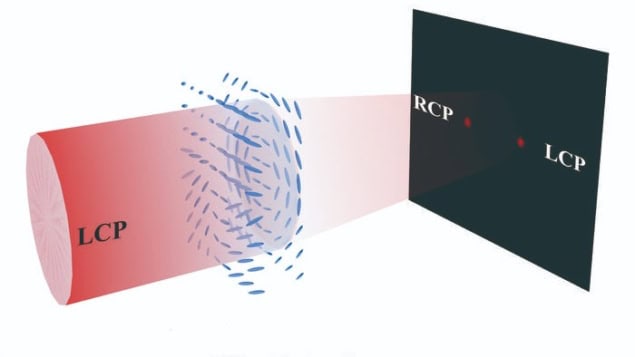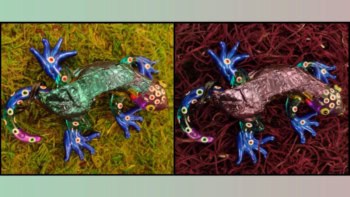
A bifocal lens that can adjust the relative intensity of its two focal points using an applied electric field has been developed by Fan Fan and colleagues at China’s Hunan University. The lens features a bilayer structure made of liquid crystal materials. Each layer responds differently to the applied electric field, splitting incoming light into oppositely polarized beams.
Bifocal lenses work by combining two distinct lens segments into one, each with a different focal length – the distance from the lens to its focal point. This gives the lens two distinct focal lengths.
While bifocals are best known for their use in vision correction, recent advances in optical materials are expanding their application in new directions. In their research, Fan’s team recognized how recent progress in holography held the potential for further innovations in the field.
Inspired by hologaphy
“Researchers have devised many methods to improve the information capacity of holographic devices based on multi-layer structures,” Fan describes. “We thought this type of structure could be useful beyond the field of holographic displays.”
To this end, the Hunan team investigated how layers within these structures could manipulate the polarization states of light beams in different ways. To achieve this, they fabricated their bifocal lens from liquid crystal materials.
Liquid crystals comprise molecules that can flow like in a liquid, but can maintain specific orientations – like molecules in a crystal. These properties make liquid crystals ideal for modulating light.
Bilayer benefits
“Most liquid-crystal-based devices are made from single-layer structures, but this limits light-field modulation to a confined area,” Fan explains. “To realize more complex and functional modulation of incident light, we used bilayer structures composed of a liquid crystal cell and a liquid crystal polymer.”
In the cell, the liquid crystal layer is sandwiched between two transparent substrates, creating a 2D material. When a voltage is applied across the cell, the molecules align along the electric field. In contrast, the molecules in the liquid-crystal polymer are much larger, and their alignment is not affected by the applied voltage.
Fan’s team took advantage of these differences, finding that each layer modulates circularly polarized light in different ways. As a result, the lens could split the light into left-handed and right-handed circularly polarized components. Crucially, each of these components is focused at a different point. By adjusting the voltage across the lens, the researchers could easily control the difference in intensity at the two focal points.
In the past, achieving this kind of control would have only been possible by the mechanical rotation of the lens layers with respect to each other. The new design is much simpler and makes it easier and more efficient to adjust the intensities at the two focal points.
Large separation distance
To demonstrate this advantage, Fan’s team used their bifocal lens in two types of imaging experiments. One was polarization imaging, which analyses differences in how left-handed and right-handed circularly polarized light interact with a sample. This method typically requires a large separation distance between focal points.
They also tested the lens in edge imaging, which enhances the clarity of boundaries in images. This requires a much smaller separation distance between focal points.

Spin-guided scattering of light is observed in a liquid crystal
By adjusting the geometric configurations within the bilayer structure, Fan’s team achieved the tight control over the separation between the focal points. In both polarization and edge imaging experiments, their bifocal lens did very well, closely matching the theoretical performance predicted by their simulations. These promising results suggest that the lens could have a wide range of applications in optical systems.
Based on their initial success, Fan and colleagues are now working to reduce the manufacturing costs of their multi-layer bifocal lenses. If successful, this would allow the lens to be used in a wide range of research applications.
“We believe that the light control mechanism we created using the multilayer structure could also be used to design other optical devices, including holographic devices and beam generators, or for optical image processing,” Fan says.
The lens is described in Optics Letters.



